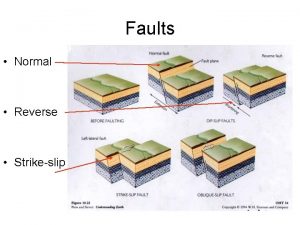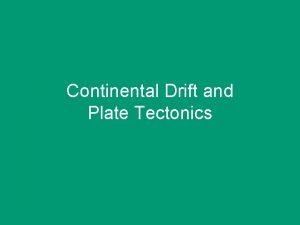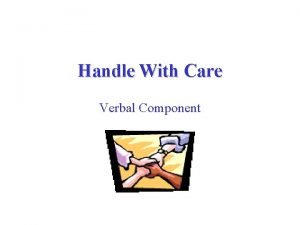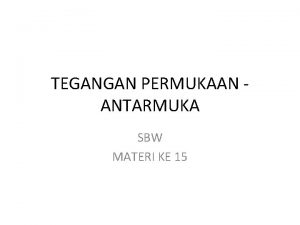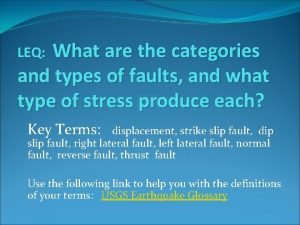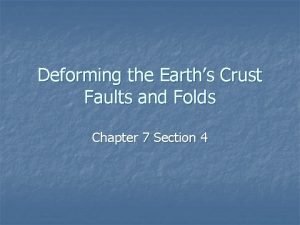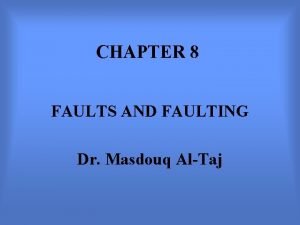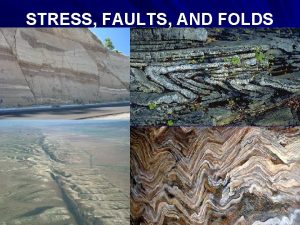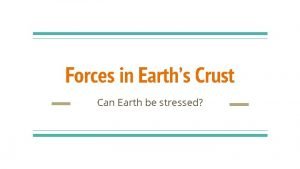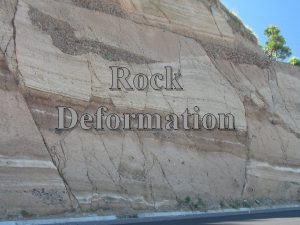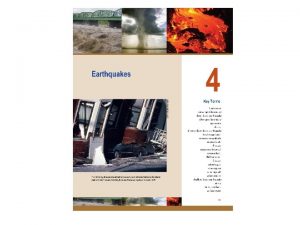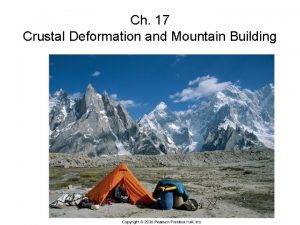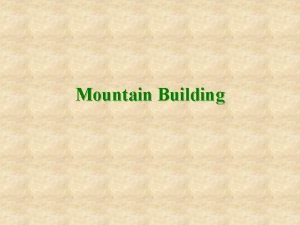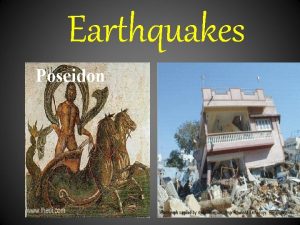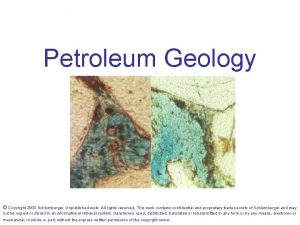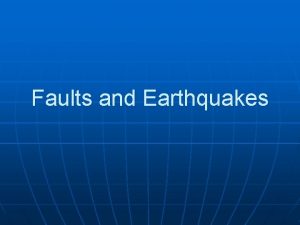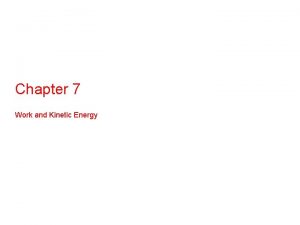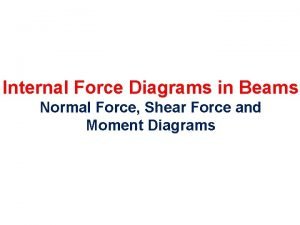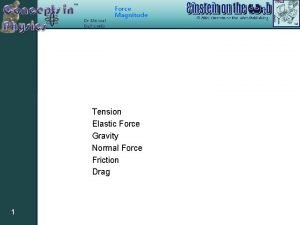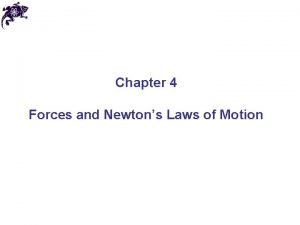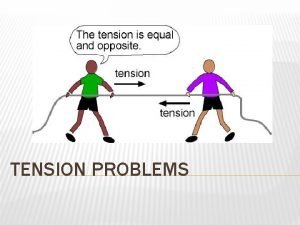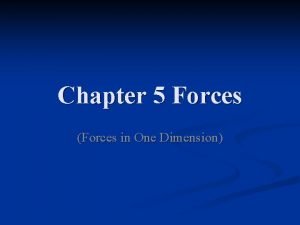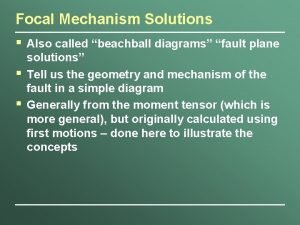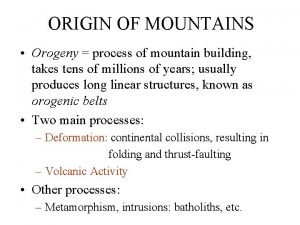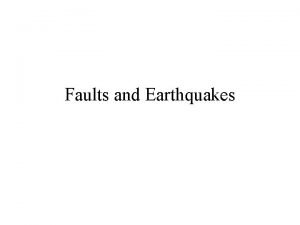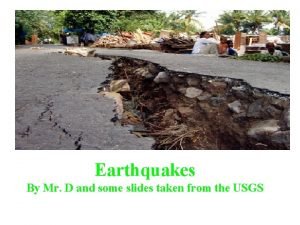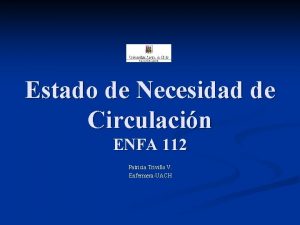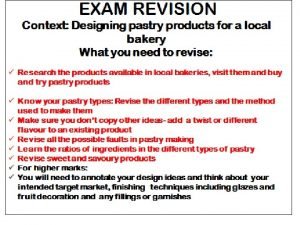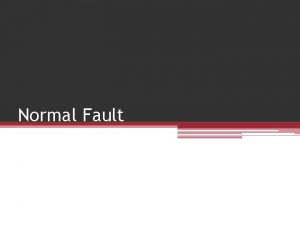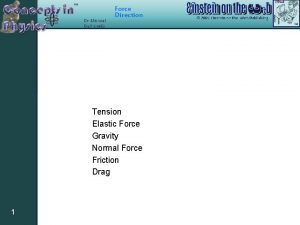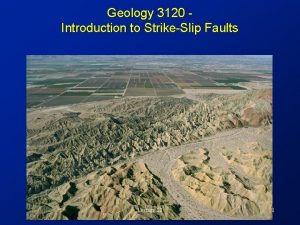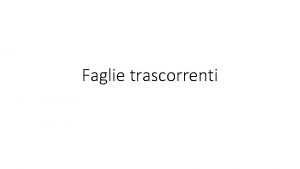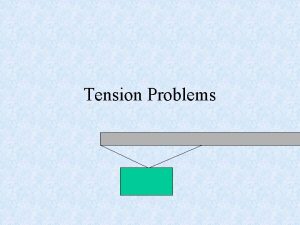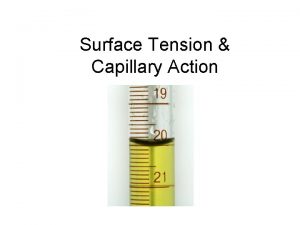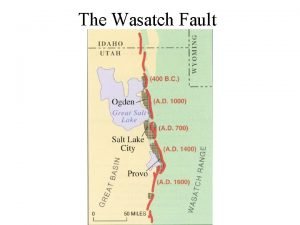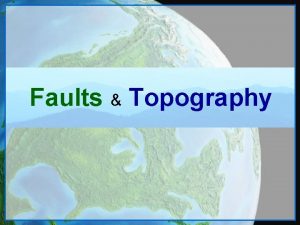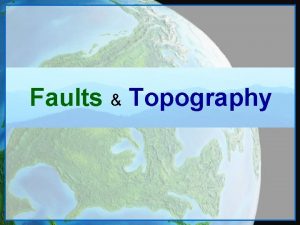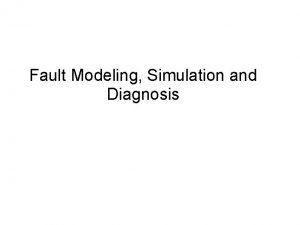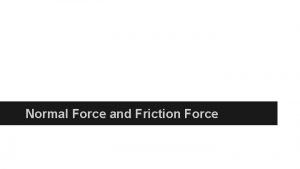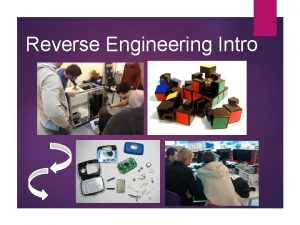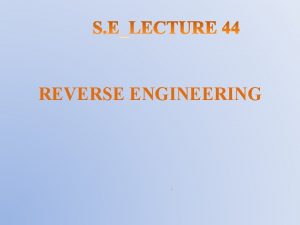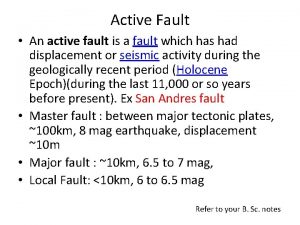Faults Normal Reverse Strikeslip Normal Fault Tension force









































- Slides: 41

Faults • Normal • Reverse • Strike-slip

Normal Fault (Tension force) Associated with divergent boundary.

Reverse Fault (Compression force) Associated with convergent boundary.

Strike-Slip Fault Associated with transform boundary.


Hot Spots • an area in the mantle from which heat rises as a thermal plume from deep in the Earth • Molten material rises in the center of a plate – Example is Hawaii. – Hotspot does not move. – Plate moves.

Hotspots Seamounts • Hotspot: Molten material rises in the center of a plate. – Example is Hawaii. – Hotspot does not move. – Plate moves.

Earth Structure and Form

Crust • Crust: Thin rocky outer layer of Earth. – Oceanic Crust: • About 7 km thick. • Rocks are much younger than the continental crust. – Continental Crust: • About 8 -75 km thick. • Mohorovicic discontinuity: Boundary between crust and mantle. – Known as “Moho”.

Mantle • Mantle: Solid rocky shell that extends to a depth of 2890 km. – Partially melted state. • Over 82 % of Earth’s volume.

Core • Core: Sphere in the center of Earth consists of iron and nickel. – Density is about 13 g/cm 3. – Source of magnetic field around Earth!

Earth’s Layers Defined by Physical Properties • Earth is divided into 5 layers based on physical properties: properties – Physical properties are: temperature, pressure, and density. 1. Lithosphere 2. Asthenosphere 3. Lower Mantle (Mesosphere) 4. Outer Core 5. Inner Core

Lithosphere and Asthenosphere • Lithosphere: Rigid outer most layer of Earth consists of the crust and upper mantle. • Asthenosphere: Highly viscous layer of the upper mantle. – Layer is weak because the temperature and pressure are just above melting point.

Lower Mantle • Lower mantle: Rigid layer that begins about 660 km below the surface. – Rocks are strong and capable of flowing. • Rocks are very hot (molten).

Inner and Outer Core • Core is composed of iron-nickel alloy. – Outer Core: Liquid layer is 2260 km thick. • Generates the Earth’s magnetic field. – Inner Core: Solid layer that is 1220 km thick. • Despite extremely high temperatures it is under immense pressure and is condensed into a solid.

Discovering Earth’s Layers • Seismic waves from earthquakes travel through the earth. – Velocity of seismic waves increases just below the crust and above the mantle known as the Mohorovicic discontinuity. • Shortened to Moho. – Example: Antarctica has records from earthquakes that occurred in California and Italy.


Mountain Building Chapter 11

Orogenesis • Orogenesis: Collection of geological processes that form mountains. – Literally means “mountain birth”. • Uplift: Upward movement of rocks through various geological processes.

Deformation • Deformation: Change in the size and shape of a rock caused by a stress. Stress: Force per unit area. • – Factors that deform rocks: 1. 2. 3. 4. Temperature Pressure Rock Type Time

Temperature and Pressure • Rocks deform in two ways: a) Brittle Deformation: Rocks changing shape by fracturing. • Rocks near the surface are under low amounts of heat and pressure. – Example: Glass fracturing or even bones fracturing. b) Ductile Deformation: Rocks changing shape without fracturing (stretch). • Rocks near high heat and pressure near the mantle and subduction zones. – Example – A penny being flattened by a train.

Rock Types a) Rocks like granite and basalt have strong molecular bonds. – Brittle deformation. – Example: Rocky Mountains, which are sharp mountains b) Rocks such as limestone have weak bonds. – Ductile deformation. – Example: Appalachian Mountains, which are gently flowing mountains.

Rock Types Rocky Mountains Appalachian Mountains

Time • Steady amounts of stress slowly make rocks “flow”. – Rocks may change shape essentially under their own weight. – Example: Marble benches under their own weight sag over the course of hundreds of years.

Types of Stress • Three types of stresses that rocks undergo: 1. Tensional Stress (Extensional) • Pulling away which causes mountain ranges and valleys. 2. Compressional Stress • Pushing inward towards each other creating a mountain range. 3. Shear Stress • Top is pulling one way and the bottom is pulling the opposite direction.

Tensional Stress • Tensional stress: Pulling away that produces mountain ranges and valleys. – Also known as extensional stress.

Compressional Stress • Compressional stress: Pushing inward towards each other creating a mountain range.

Shearing Stress • Shearing stress: Top is pulling one way and the bottom is pulling the opposite direction.

Folds • Folds: Series of wavelike ripples in rock layers. • Three main types of folds: 1. Anticlines 2. Synclines 3. Monoclines

Anticline • Anticlines: Caused by the upfolding or arching of rock layers.

Syncline • Synclines: Downward fold or troughs associated with anticlines.

syncline anticline

Monocline • Monoclines: Large step like fold associated with a fault.

Folded Mountains • Mountains that form from folding processes. – Compressional stress. – Examples: Appalachian and Alps

• Mountain Fold Video – 2. 2 minutes – Anticline and Syncline Information

Fault Block Mountains • Large blocks of rock are uplifted and tilted by normal faults. – Example: Grand Teton Mountains in Wyoming

Fault Block Mountains

• Fault Block Video – 1. 2 minutes

Volcanic Mountains • Formed by lava and pyroclastic material build up. – Example: Hawaii, Surtsey in 1963 Surtsey in 1999

Domes and Basins Domes: Occur where up -warping produces a circular or elongated arched structure. Basins: Occur where down-warped structures have a circular shape.

Horsts and Grabens • Horsts: Elongated, uplifted block of rock along a fault. • Grabens: Valley formed by the displacement by a block of rock along a fault.
 Lower mantle
Lower mantle Normal reverse and transform faults
Normal reverse and transform faults High surface tension vs low surface tension
High surface tension vs low surface tension Countertransference
Countertransference Energi bebas permukaan
Energi bebas permukaan Reverse fault animation
Reverse fault animation Hanging wall faults
Hanging wall faults Heave and throw of a fault
Heave and throw of a fault Thrust fault
Thrust fault Type of fault
Type of fault Strike slip fault
Strike slip fault Which type of stress causes fault-block mountains?
Which type of stress causes fault-block mountains? Reverse fault
Reverse fault Stress faults
Stress faults Reverse fault
Reverse fault Accretion geology
Accretion geology Cause
Cause Reverse fault
Reverse fault Example of transform plate boundary
Example of transform plate boundary Normal faults
Normal faults Normal faults
Normal faults Hooke's law vector form
Hooke's law vector form Internal forces examples
Internal forces examples Two objects sliding past each other experience
Two objects sliding past each other experience Normal force symbol
Normal force symbol Tension force
Tension force How to solve for tension
How to solve for tension Why does everything fall at the same speed
Why does everything fall at the same speed Air resistance non contact force
Air resistance non contact force Focal mechanism beach ball
Focal mechanism beach ball Normal fault
Normal fault Fastest path
Fastest path Dip slip fault vs strike slip
Dip slip fault vs strike slip Types of fault
Types of fault Tabla de presión arterial por edad
Tabla de presión arterial por edad Normal phase vs reverse phase chromatography
Normal phase vs reverse phase chromatography M tswett pronunciation
M tswett pronunciation Normal phase vs reverse phase chromatography
Normal phase vs reverse phase chromatography Normal calculations in reverse
Normal calculations in reverse Types of sentence faults
Types of sentence faults Classimat faults table
Classimat faults table What is the flour to fat ratio for short pastry?
What is the flour to fat ratio for short pastry?
